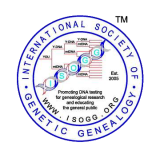Unique-event polymorphism
From ISOGG Wiki
In genetic genealogy a unique-event polymorphism (UEP) is a genetic marker that corresponds to a mutation which is likely to occur so infrequently that it is believed overwhelmingly probable that all the individuals who share the marker, worldwide, will have inherited it from the same common ancestor, and the same single mutation event. Generally, UEP is an allele for which all copies derive from a single mutational event.
In genetic genealogy the mutations considered to be UEPs can be any germline mutation but are usually single-nucleotide polymorphisms – the replacement of one letter by another in the DNA sequence. The terms UEP and SNP are often loosely used interchangeably, but UEPs may also be large-scale additions, such as the YAP insertion which defines Y-DNA haplogroups D and E, inversion or deletions.
The discovery and widespread testing of new UEPs has been the key to the increasingly detailed analysis of the patrilineal and matrilineal ancestry of mankind into ever more precise family trees of Y chromosome DNA and mitochondrial DNA haplogroups. UEPs in the X chromosome autosomal chromosomes are also used to trace genealogy extending time ranges available for Y-DNA and mtDNA.
Comparison with short tandem repeats (STRs)
The properties of UEPs can be contrasted with those of short tandem repeat sequences (STRs), the other main type of genetic variation made use of in genealogical DNA testing.
Unlike UEPs, STR sequences are highly variable, and there is a significant probability that one of a set may have changed its repeat number after only a few generations. That makes a particular STR haplotype much more specific, matching a much smaller number of people. But it also means, at least in the case of Y-STR markers, that quite unrelated lineages may have converged to the same combination of Y-STR markers entirely independently by different routes.
Exceptionally, there are a few cases where Y-STR markers can take on the status of UEPs, typically where a large-scale deletion event may have occurred, causing a sudden big change in the Y-STR repeat number rather than the usual single increment or decrement, which can be considered to have been a unique one-off in a group of lineages. Such a change in DYS 413 for example distinguishes subgroup J2a1 from J2a in Y-DNA Haplogroup J.
External links
- ISOGG Y-DNA UEP Index
